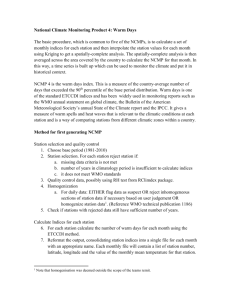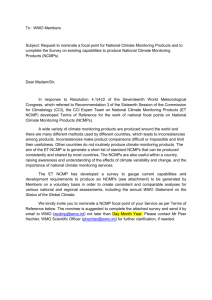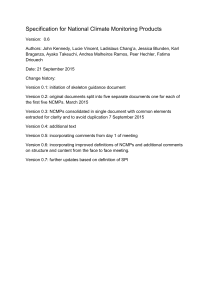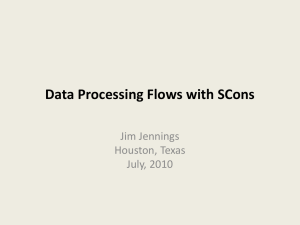Version 0.3 of the draft guidance on NCMPs
advertisement
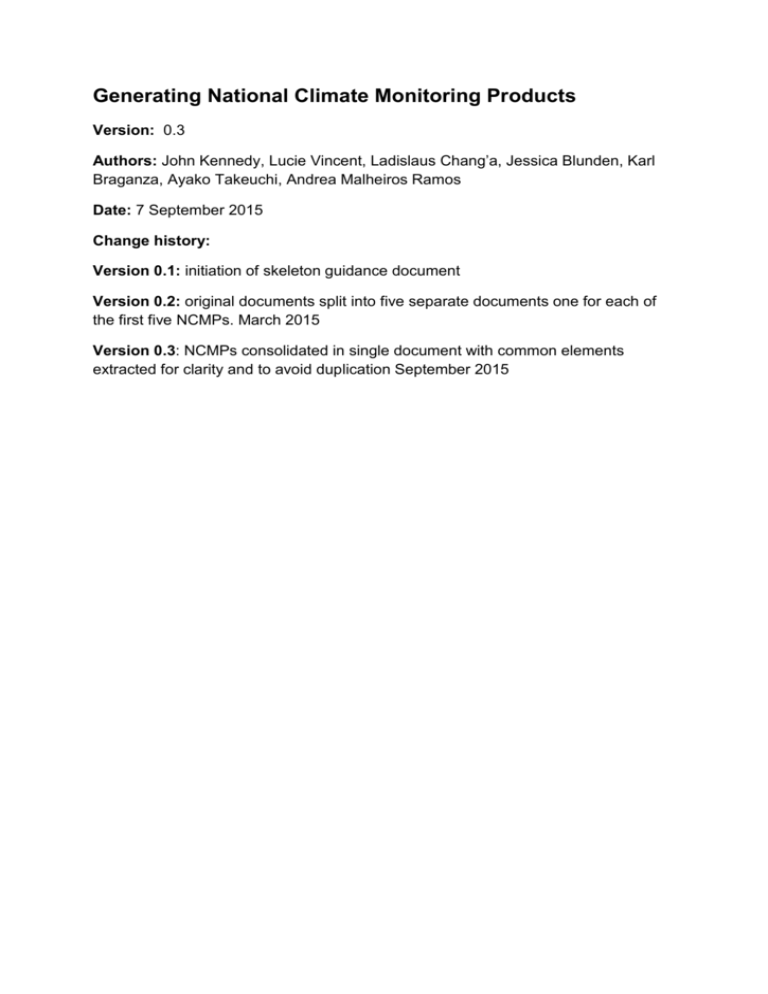
Generating National Climate Monitoring Products Version: 0.3 Authors: John Kennedy, Lucie Vincent, Ladislaus Chang’a, Jessica Blunden, Karl Braganza, Ayako Takeuchi, Andrea Malheiros Ramos Date: 7 September 2015 Change history: Version 0.1: initiation of skeleton guidance document Version 0.2: original documents split into five separate documents one for each of the first five NCMPs. March 2015 Version 0.3: NCMPs consolidated in single document with common elements extracted for clarity and to avoid duplication September 2015 Contents 1 Introduction ............................................................................................................. 4 1.1 NCMP 1: Mean Temperature ............................................................................ 4 1.2 NCMP 2: percentage rainfall. ............................................................................ 4 1.3 NCMP 3: standardized precipitation index ........................................................ 4 1.4 NCMP 4: warm days ......................................................................................... 5 1.5 NCMP 5: cold nights ......................................................................................... 5 1.6 NCMP 6: extremes of temperature and precipitation ........................................ 5 1.7 Limitations and strengths of NCMPs ................................................................. 5 2 Generating the products .......................................................................................... 7 2.1 Quality control ................................................................................................... 7 2.2 Generate the indices ......................................................................................... 8 2.2.1 Monthly mean temperature anomaly .......................................................... 8 2.2.2 Monthly percentage rainfall ........................................................................ 8 2.2.3 Standardised Precipitation Index................................................................ 8 2.2.4 Warm days ................................................................................................. 8 2.2.5 Cold nights ................................................................................................. 8 2.3 Calculating a variogram .................................................................................... 8 2.3.1 Method for calculating the variogram ......................................................... 9 2.3.2 Suitable functional forms for the variogram ................................................ 9 2.4 Interpolating the data ...................................................................................... 10 2.4.1 Method for interpolating the data .............................................................. 10 2.4.2 Ordinary Kriging Method .......................................................................... 10 2.5 Averaging the index ........................................................................................ 11 2.6 Output of the NCMP ....................................................................................... 11 2.7 NCMP 6: extremes of temperature and precipitation ...................................... 11 2.7.1 The hierarchy ........................................................................................... 11 2.8 Monthly and annual updates ........................................................................... 13 2.8.1 Monthly updates ....................................................................................... 13 2.8.2 Annual updates ........................................................................................ 13 3 Dissemination ........................................................................................................ 14 3.1 Data formats ................................................................................................... 14 3.2 Dissemination via focal points......................................................................... 14 3.3 Dissemination via BUFR message ................................................................. 14 3.4 Dissemination via the web .............................................................................. 14 4 Q&A....................................................................................................................... 15 1 Introduction Due to the impact of current climate conditions on society and ecosystems, a variety of climate monitoring products have been created by countries around the world at different spatial and temporal scales. National Climate Monitoring Products (NCMPs) are products that summarise climate conditions at a national scale. NCMPs are useful within a country, raising awareness and understanding of the effects of climate variability and change, and the importance of national monitoring networks and services. At an international level, they aid the synthesis of national information to provide a broad, global view of climate variability and change. Currently, a wide variety of climate monitoring products are produced around the world and there are many inconsistencies between the methods used by different countries. Inconsistencies make comparisons between these products difficult or impossible, and limit their usefulness. The aim of this document is to describe a short list of standard NCMPs that can be produced consistently and easily by most countries. This is the result of considerations by the Task Team and Expert Team on National Climate Monitoring Products. 1.1 NCMP 1: Mean Temperature NCMP 1 is mean temperature. This is a simple measure of the country-average temperature anomaly for the month, which can be easily converted to give an average temperature anomaly for the year, or any other period. Mean temperature is a standard metric used to monitor climate change and is widely used in monitoring reports such as the WMO annual statement on global climate, the Bulletin of the American Meteorological Society’s annual State of the Climate report and the IPCC. It is a measure of overall warmth or cold, but does not distinguish between high maximum temperatures and high minimum temperatures which can have different impacts. 1.2 NCMP 2: percentage rainfall. NCMP 2 is percentage rainfall. This is a simple measure of the country-average rainfall anomaly expressed as a percentage of the base-period average for the month. Precipitation percentage is a standard metric used to monitor climate change and is widely used in monitoring reports such as the WMO annual statement on global climate, the Bulletin of the American Meteorological Society’s annual State of the Climate report and the IPCC. 1.3 NCMP 3: standardized precipitation index NCMP 3 is standardized precipitation index. This is a measure of the countryaverage standardized rainfall anomaly. SPI is a standard metric used to monitor rainfall and is widely used in monitoring reports such as the WMO annual statement on global climate, the Bulletin of the American Meteorological Society’s annual State of the Climate report and the IPCC. Because SPI is adapted to the climatic conditions at a particular station, it is a way of comparing stations from different climatic zones within a country and between countries where the mean and variability of rainfall might differ substantially. 1.4 NCMP 4: warm days NCMP 4 is the warm-days index. This is a measure of the country-average number of days that exceeded the 90th percentile of the base period distribution. Warm days is one of the standard ETCCDI indices and has been widely used in monitoring reports such as the WMO annual statement on global climate, the Bulletin of the American Meteorological Society’s annual State of the Climate report and the IPCC. It gives a measure of warm spells and heat waves that is relevant to the climatic conditions at each station and is a way of comparing stations from different climatic zones within a country. 1.5 NCMP 5: cold nights NCMP 5 is the cold-nights index. This is a measure of the country-average number of days that fell below the 10th percentile of the base period distribution. Cold nights is one of the standard ETCCDI indices and has been widely used in monitoring reports such as the WMO annual statement on global climate, the Bulletin of the American Meteorological Society’s annual State of the Climate report and the IPCC. It gives a measure of cold spells and cold waves that is relevant to the climatic conditions at each station and is a way of comparing stations from different climatic zones within a country. 1.6 NCMP 6: extremes of temperature and precipitation This product is a list of extremes of temperature and precipitation, recording such things as national and station records of maximum temperature, minimum temperature and precipitation. The aim is to flag extreme events, and provide some information 1.7 Limitations and strengths of NCMPs By providing country level information, NCMPs have some obvious weaknesses, limitations and strengths. The most obvious is that a country is not an obvious climatic unit. Climates can vary within a country sometimes to a very great extent. Thus, local information will be lost in calculating NCMPs. Balanced against this is the fact that NCMPs by averaging out local variations in temperature and precipitation will make other, more subtle, chances evident. And, while a country is not a coherent climatic unit, it is a coherent psychological one. People from across society are used to thinking at this level: GDP, population, and other indicators are routinely calculated and discussed at this level. Care must also be taken when comparing an NCMP to output from a climate model. It is necessary to consider whether the thing measured is exactly comparable to the thing modelled. Differences can arise when the order of aggregation is rearranged and these differences can be marked if the indices are calculated before the gridding, rather than after. Uncertainty has not been explicitly addressed in what follows. All indices are however subject to errors that arises from many sources, including undetected errors in the data, measurement limitations (for example, data are occasionally rounded to the nearest whole degree), software errors, limitations of the interpolation techniques, poorly specified statistical models, ambiguities in the definitions, poor station siting. A thorough uncertainty analysis is beyond the scope of this initial guidance, but should be considered in the future. 2 Generating the products The basic procedure, which is common to the first five NCMPs, is to calculate a set of monthly indices for each station and then interpolate the station values for each month using Kriging to get a spatially-complete analysis. The spatially-complete analysis is then averaged across the area covered by the country to calculate the NCMP for that month. In this way, a time series is built up which can be used to monitor the climate and put it in historical context. The basic method for the first five NCMPs is 1. Quality control the daily temperature and precipitation data (See 2.1 Quality control) 2. Generate the indices (See 2.2 Generate the indices) 3. Calculate the variograms for each index (See 2.3 Calculating a variogram) 4. Interpolate the data for each index (See 2.4 Interpolating the data) 5. Average each index across the country (See 2.5 Averaging the index) 6. Output the NCMP (See 2.6 Output of the NCMP) The sixth NCMP is somewhat different and is described in Section 2.7 NCMP 6: extremes of temperature and precipitation. 2.1 Quality control The aim of quality control is to ensure that stations have sufficient data to calculate the necessary indices and that the data are not contaminated with data that are incorrect or otherwise badly in error. A secondary aim is to identify whether the data have been homogenised. The basic method is as follows: 1. Fix the base period (1981-2010) 2. Station selection. For each station reject station if: a. missing data criteria is not met b. number of years in climatology period is insufficient to calculate indices c. the site does not meet WMO standards 3. Quality control the data. There is functionality to do this within the RCLIMDEX software, which checks for internal consistency as well as for gross outliers. RH test could be an additional aid. 4. Homogenization, for daily data: EITHER a. flag data as suspect OR b. reject inhomogeneous sections of station data if necessary based on user judgement aided by RH test from RClimdex OR c. homogenize station data1. (Reference WMO technical publication 1186) 5. Check if stations with rejected data still have sufficient data. 1 Note that describing methods for homogenisation was deemed outside the scope of the ET-NCMP remit. There are WMO initiatives to do this already. 2.2 Generate the indices The indices will form the basis for the next stages. There are five different indices that need to be calculated, which are briefly described in the next subsections. Each of the indices needs to be calculated separately for each station. For the final three indices (warm days, cold nights and SPI), the processing can be done using the CLIMPACT software. 2.2.1 Monthly mean temperature anomaly The daily mean temperature is defined as the average of the maximum and minimum temperatures for the day. The monthly mean temperature is the average of the daily mean temperatures for that month. A climatological average is calculated for each month. For January, take the average of all monthly mean temperatures for Januarys in the climatology period, 1981-2010. The monthly mean temperature anomaly is the difference between the month mean temperature and the climatological average for that month. 2.2.2 Monthly percentage rainfall The monthly total rainfall is the sum of the daily precipitation totals. A climatological average is calculated for each month. For January, take the average of all monthly total rainfalls for Januarys in the climatology period, 1981-2010. The monthly percentage rainfall is the monthly total rainfall divided by the climatological average. 2.2.3 Standardised Precipitation Index The monthly total rainfall is the sum of the daily precipitation totals. For each station, fit a Pearson Type-III distribution to the monthly precipitation totals for the base period, 1981-2010. Use the fitted distribution to standardize the monthly precipitation totals. SPI has recently been added to the ET-SCI list of indices, so we won’t need to calculate this one specifically. 2.2.4 Warm days For each station calculate the number of warm days for each month using the ETCCDI method. 2.2.5 Cold nights For each station calculate the number of cold nights for each month using the ETCCDI method. 2.3 Calculating a variogram A variogram describes how much you expect the index (mean temperature anomaly, for example) to change as you move away from a point. It is found by plotting half the squared difference in the index at all pairs of stations as a function of the distance between them. This is called the empirical variogram. It is always positive and is typically small for small separations and larger for large separations. In order to do the interpolation, we need a function which can be used to give an estimate of what the variogram would be for any separation. This is found by fitting a particular functional variogram model to the empirical variogram. A separate variogram model will have to be calculated for each index and for each calendar month. A reliable variogram model can only be calculated if there are a more than around 10 stations. 2.3.1 Method for calculating the variogram a) Read in the index for all 30 Januarys and for all n stations in the base period (1981-2010). b) For each January and each pair of stations, calculate the squared difference in the index reported at each station and the distance between the stations. There should be at most 30*(n2-n) difference/distance pairs. c) Choose a maximum separation for the empirical variogram. Typically, the maximum separation of stations, or around 2000km for precipitation and 3000 km for temperature are good first guesses. d) Sort the difference/distance pairs into bins of equal distance (20km is a reasonable first guess) from zero to the maximum distance. For example, the first “bin” would be from 0-20 km, the second from 20-40 km and so on up to 1980-2000 km. e) In each bin average all the squared differences together and divide by two. f) Plot the empirical variogram. At this point, it might be necessary to adjust the maximum distances and bin size and repeat (c) and (d) until the variogram looks “sensible”. Sensible means that it rises steadily to a maximum value. g) Find a function and parameters that best fits the data. Some typical functional forms (spherical, Gaussian, exponential) are given below. The fit can be done by eye, or (better) by minimizing the summed absolute differences or summed squared differences between the functional form (evaluated at the centre of each bin) and the empirical variogram. h) Repeat (a)-(g) for February, March etc. i) At the end you should have a preferred functional form and parameters for each calendar month that can be used in the interpolation. 2.3.2 Suitable functional forms for the variogram In each case, h is the distance between two stations. There are three parameters, s,n and r: s is the value of the sill which is the value of the variogram at very large distance; n is the nugget which is the value of the variogram at zero separation; and r is the characteristic length scale of the variogram. V is the value of the variogram. Exponential V(h) = (s-n)(1 – exp(-h/r)) + n Spherical V(h) = (s-n)( 3h/2r – h3/2r3) + n, for h<r V(h) = s, for h>r Gaussian V(h) = (s-n)(1 – exp(-h2/r2a)) + n Other forms There are other possible forms for the variogram. Typically, the function needs (1) to increase monotonically with increasing distance, (2) to be constant at very large distances, (3) be positive at all separations. 2.4 Interpolating the data In order to get an estimate of the average of an index (mean temperature anomaly, for example) across a country, we need to estimate what the index was in the gaps between stations. The method we will use to do this is called Ordinary Kriging. It is a method widely used in geostatistics. The method naturally accounts for the uneven distribution of stations and provides a reasonable, though not perfect, estimate of what the index would be at intermediate locations. Here we will use Ordinary Kriging to estimate the value of the index at points on a regular grid, which covers the country. 2.4.1 Method for interpolating the data a) Define a regular latitude-longitude grid across the country ensuring that there are sufficient grid cells to resolve the major outline of the country. In order to resolve variability within the country, ensure that there are at least 100 grid boxes in total. b) Read in data for all stations for one month (e.g. March 1999) c) Read in the variogram for that month. d) Use Ordinary Kriging together with the station data and the variogram to estimate the values at each of the grid-cell centres e) Output the interpolated data. 2.4.2 Ordinary Kriging Method a) Arrange the data from the n stations into a vector, y, with (n+1,1) elements. The first n elements are the station data values and the final element is set to 1. b) Create a matrix, C, with (n+1,n+1) elements the ith,jth elements of the matrix is equal to V(h) where h is the distance between the ith and jth station and V is the value of the variogram model for that separation. The (n+1)th row and (n+1)th column are set to contains 1s and the (n+1),(n+1) element is set to zero. c) For each gridcell calculate a matrix D with (n+1,1) elements. The ith element of the vector is equal to V(h) where h is the distance between the gridcell centre and the ith station and V is equal to the value of the variogram model for that separation. The (n+1)th element is set to 1. d) Calculate yTC-1D, which gives the interpolated value for the gridcell. e) Repeat (c) and (d) for each grid cell. 2.5 Averaging the index a) Read in interpolated data for one month (e.g. March 1999) b) Overlay country boundaries and mask out grid cells outside the boundaries. c) Calculate the area of each grid cell. Where a grid cell falls wholly within the country’s borders the area is set equal to the area of the grid cell. Where a grid cell is divided by the borders of the country, calculate the area of the grid cell that falls within the country’s boundary. d) Calculate average from all grid cells weighted by the area of the grid cell within the country including both complete and incomplete grid cells. This is the NCMP for the month 2.6 Output of the NCMP a) Write out NCMP for this month in standard format (Year, Month, Country, NCMP indicator, NCMP value, Number of stations contributing, lowest quality flag, length of record, normal period). b) Combine individual NCMPs into standard format and transmit combined NCMP in agreed format via agreed protocol (See Section 3 Dissemination). 2.7 NCMP 6: extremes of temperature and precipitation The sixth NCMP is somewhat different to the other five. Its purpose is to flag extremes of temperature and precipitation. There is a hierarchy of interest with national record of temperature and precipitation at the top and monthly station records for some specified period (e.g. the past ten years) at the bottom. 2.7.1 The hierarchy Using the daily and monthly temperatures and the daily and monthly rainfall, run through the following list and report preferentially, the even that occurs highest in the list All-time country-wide records 1. A station reports: a daily maximum temperature that is higher than the current country-wide daily maximum temperature record for any month; a daily minimum temperature that is lower than the current country-wide daily minimum temperature record for any month; or the highest daily precipitation total for any month. (mnemonic: all-time highest daily highs for country) 2. A station reports: a daily maximum temperature that is lower than the current country-wide daily maximum temperature record for any month; or a daily minimum temperature that is higher than the current country-wide daily minimum temperature record for any month. (mnemonic: all-time lowest daily highs for country) 3. A station reports: a monthly average maximum temperature that is higher than the current country-wide monthly average maximum temperature record for any month; a monthly average minimum temperature that is lower than the current country-wide monthly average minimum temperature record for any month; or a monthly rainfall total that is higher than the current country-wide monthly rainfall total. (mnemonic: all-time highest monthly highs for country) 4. A station reports: a monthly average maximum temperature that is lower than the current country-wide monthly average maximum temperature record for any month; a monthly average minimum temperature that is higher than the current country-wide monthly average minimum temperature record for any month; or a monthly rainfall total that is lower than the current country-wide monthly rainfall total. (mnemonic: all-time lowest monthly highs for country) Seasonal country-wide records 5. 6. 7. 8. As for 1. but only for this calendar month As for 2. but only for this calendar month As for 3. but only for this calendar month As for 4. but only for this calendar month All-time station records 9. As for 1. but only for that station. 10. As for 2. but only for that station. 11. As for 3. but only for that station. 12. As for 4. but only for that station. Seasonal station records 13. As for 1. but only for that calendar month and station 14. As for 2. but only for that calendar month and station 15. As for 3. but only for that calendar month and station 16. As for 4. but only for that calendar month and station Runs of warm nights or cold days 17. For each station, find the longest series of consecutive warm days and the longest series of consecutive cold nights. If either one of these exceeds current record long series, report that. 18. As for 17 but for that calendar month only. Most extreme since type records 19. For each station and for each of the highest and lowest daily maximum temperatures, the highest and lowest daily minimum temperatures and the highest and lowest daily precipitation totals, calculate the time that has elapsed since the index was last higher (or lower). If that time is greater than ten years, then report that. If multiple stations meet this criteria, report the longest such period. 2.8 Monthly and annual updates The methods described so far, are intended to create the initial NCMP. However, the aim is to update these each month. 2.8.1 Monthly updates When performing monthly updates, it is necessary to quality control and process only a single month of data. It is not necessary to recalculate the variogram that is used in the interpolation step. 2.8.2 Annual updates When performing annual updates, it is necessary to check whether the climatology period has changed. At the time of writing this should be 1981-2010, but when this period is updated to 1991-2020, then the NCMPs will need to be recalculated from the beginning. 3 Dissemination The exact details of this – formats and messages – are still to be determined… 3.1 Data formats Not yet decided 3.2 Dissemination via focal points The focal point within each country should ensure that the NCMPs are calculated on a monthly basis and that they are sent to the appropriate regional centre. The focal point should also be prepared to send the NCMPs in response to specific requests, either via email or by directing the person making the request to a web site where the NCMPs can be found. 3.3 Dissemination via BUFR message The focal point within each country will also be responsible for ensuring that the NCMPs are transmitted via an appropriate BUFR message. 3.4 Dissemination via the web It is recommended that the NCMPs are also disseminated via the NMHS website on a dedicated web page. This will allow for the widest dissemination of the NCMPs to a range of stakeholders including fellow scientists, journalists, policy makers as well as interested members of the public. To aid sharing, aggregation and comparison between countries, the standard formats should be used. 4 Q&A Q: What is the value of a single number that summarises climate conditions across a country when those conditions can vary so widely? A: Climate conditions vary across most countries, and most regions. Nonetheless, there is value in summarising conditions across a large area. Aggregation can reveal longer-term changes in the large scale climate of a country that can be hidden by focusing exclusively on individual weather events. If temperatures are unusually high or low across a whole country, this will show up very clearly in the NCMPs. It is also worth considering the experience of those countries that do already produce NCMPs. There is a general interest in NCMPs, which can help to inform the public and policy makers about the important role that climate variability and change can play in their lives. Q: A:
